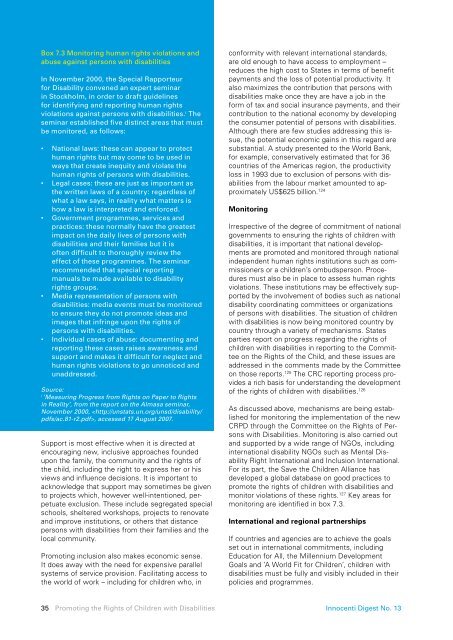Promoting the Rights of Children with Disabilities, UNICEF
Promoting the Rights of Children with Disabilities, UNICEF
Promoting the Rights of Children with Disabilities, UNICEF
- No tags were found...
Create successful ePaper yourself
Turn your PDF publications into a flip-book with our unique Google optimized e-Paper software.
Box 7.3 Monitoring human rights violations andabuse against persons <strong>with</strong> disabilitiesIn November 2000, <strong>the</strong> Special Rapporteurfor Disability convened an expert seminarin Stockholm, in order to draft guidelinesfor identifying and reporting human rightsviolations against persons <strong>with</strong> disabilities. i Theseminar established five distinct areas that mustbe monitored, as follows:• National laws: <strong>the</strong>se can appear to protecthuman rights but may come to be used inways that create inequity and violate <strong>the</strong>human rights <strong>of</strong> persons <strong>with</strong> disabilities.• Legal cases: <strong>the</strong>se are just as important as<strong>the</strong> written laws <strong>of</strong> a country: regardless <strong>of</strong>what a law says, in reality what matters ishow a law is interpreted and enforced.• Government programmes, services andpractices: <strong>the</strong>se normally have <strong>the</strong> greatestimpact on <strong>the</strong> daily lives <strong>of</strong> persons <strong>with</strong>disabilities and <strong>the</strong>ir families but it is<strong>of</strong>ten difficult to thoroughly review <strong>the</strong>effect <strong>of</strong> <strong>the</strong>se programmes. The seminarrecommended that special reportingmanuals be made available to disabilityrights groups.• Media representation <strong>of</strong> persons <strong>with</strong>disabilities: media events must be monitoredto ensure <strong>the</strong>y do not promote ideas andimages that infringe upon <strong>the</strong> rights <strong>of</strong>persons <strong>with</strong> disabilities.• Individual cases <strong>of</strong> abuse: documenting andreporting <strong>the</strong>se cases raises awareness andsupport and makes it difficult for neglect andhuman rights violations to go unnoticed andunaddressed.Source:i’Measuring Progress from <strong>Rights</strong> on Paper to <strong>Rights</strong>in Reality’, from <strong>the</strong> report on <strong>the</strong> Almasa seminar,November 2000, , accessed 17 August 2007.Support is most effective when it is directed atencouraging new, inclusive approaches foundedupon <strong>the</strong> family, <strong>the</strong> community and <strong>the</strong> rights <strong>of</strong><strong>the</strong> child, including <strong>the</strong> right to express her or hisviews and influence decisions. It is important toacknowledge that support may sometimes be givento projects which, however well-intentioned, perpetuateexclusion. These include segregated specialschools, sheltered workshops, projects to renovateand improve institutions, or o<strong>the</strong>rs that distancepersons <strong>with</strong> disabilities from <strong>the</strong>ir families and <strong>the</strong>local community.<strong>Promoting</strong> inclusion also makes economic sense.It does away <strong>with</strong> <strong>the</strong> need for expensive parallelsystems <strong>of</strong> service provision. Facilitating access to<strong>the</strong> world <strong>of</strong> work – including for children who, inconformity <strong>with</strong> relevant international standards,are old enough to have access to employment –reduces <strong>the</strong> high cost to States in terms <strong>of</strong> benefitpayments and <strong>the</strong> loss <strong>of</strong> potential productivity. Italso maximizes <strong>the</strong> contribution that persons <strong>with</strong>disabilities make once <strong>the</strong>y are have a job in <strong>the</strong>form <strong>of</strong> tax and social insurance payments, and <strong>the</strong>ircontribution to <strong>the</strong> national economy by developing<strong>the</strong> consumer potential <strong>of</strong> persons <strong>with</strong> disabilities.Although <strong>the</strong>re are few studies addressing this issue,<strong>the</strong> potential economic gains in this regard aresubstantial. A study presented to <strong>the</strong> World Bank,for example, conservatively estimated that for 36countries <strong>of</strong> <strong>the</strong> Americas region, <strong>the</strong> productivityloss in 1993 due to exclusion <strong>of</strong> persons <strong>with</strong> disabilitiesfrom <strong>the</strong> labour market amounted to approximatelyUS$625 billion. 124MonitoringIrrespective <strong>of</strong> <strong>the</strong> degree <strong>of</strong> commitment <strong>of</strong> nationalgovernments to ensuring <strong>the</strong> rights <strong>of</strong> children <strong>with</strong>disabilities, it is important that national developmentsare promoted and monitored through nationalindependent human rights institutions such as commissionersor a children’s ombudsperson. Proceduresmust also be in place to assess human rightsviolations. These institutions may be effectively supportedby <strong>the</strong> involvement <strong>of</strong> bodies such as nationaldisability coordinating committees or organizations<strong>of</strong> persons <strong>with</strong> disabilities. The situation <strong>of</strong> children<strong>with</strong> disabilities is now being monitored country bycountry through a variety <strong>of</strong> mechanisms. Statesparties report on progress regarding <strong>the</strong> rights <strong>of</strong>children <strong>with</strong> disabilities in reporting to <strong>the</strong> Committeeon <strong>the</strong> <strong>Rights</strong> <strong>of</strong> <strong>the</strong> Child, and <strong>the</strong>se issues areaddressed in <strong>the</strong> comments made by <strong>the</strong> Committeeon those reports. 125 The CRC reporting process providesa rich basis for understanding <strong>the</strong> development<strong>of</strong> <strong>the</strong> rights <strong>of</strong> children <strong>with</strong> disabilities. 126As discussed above, mechanisms are being establishedfor monitoring <strong>the</strong> implementation <strong>of</strong> <strong>the</strong> newCRPD through <strong>the</strong> Committee on <strong>the</strong> <strong>Rights</strong> <strong>of</strong> Persons<strong>with</strong> <strong>Disabilities</strong>. Monitoring is also carried outand supported by a wide range <strong>of</strong> NGOs, includinginternational disability NGOs such as Mental DisabilityRight International and Inclusion International.For its part, <strong>the</strong> Save <strong>the</strong> <strong>Children</strong> Alliance hasdeveloped a global database on good practices topromote <strong>the</strong> rights <strong>of</strong> children <strong>with</strong> disabilities andmonitor violations <strong>of</strong> <strong>the</strong>se rights. 127 Key areas formonitoring are identified in box 7.3.International and regional partnershipsIf countries and agencies are to achieve <strong>the</strong> goalsset out in international commitments, includingEducation for All, <strong>the</strong> Millennium DevelopmentGoals and ’A World Fit for <strong>Children</strong>’, children <strong>with</strong>disabilities must be fully and visibly included in <strong>the</strong>irpolicies and programmes.35 <strong>Promoting</strong> <strong>the</strong> <strong>Rights</strong> <strong>of</strong> <strong>Children</strong> <strong>with</strong> <strong>Disabilities</strong> Innocenti Digest No. 13
















